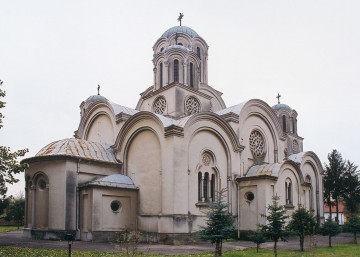The Serbian Orthodox Church in Ada is dedicated to the Lord’s Eucharist. It was built at the site of the earlier church from 1760. The previous church was devoted to Blaspheming, and it was in a fire during the 1848/49 revolution. years.
Today’s church was built in a short period of time from 1925/26. After the project of Daka Popovic whose imagination was inspired by the beauty of our medieval monasteries built in the Serbian-Byzantine style, this impressive work has been created, both because of its proportions and because of the richness of its exterior decoration, as well as because of the paintings in the interior. With its monumentality and precision, the term stands out in the Serbian Orthodox architecture of the first half of the 20th century. It is also a rare dome church erected in a populated place opposite the “uniformed” pro-Baroque Orthodox temples of the 18th and 19th centuries. The church in Ada will remain one of the few attempts to “restore the Serbian national style” in the area of Vojvodina.
It is a five-fold structure of the base in the form of an inscribed cross covered on all four sides by a lower ship in each corner of which is one dome – paraclass. The form of the cross is particularly visible in the roofs. From the square stand on which the dome is, on all four sides there are four main vaults forming a cross. The rooftops in the corners between the arms of the cross are lower and there are four smaller domes.
The richness of the imagination of the designer is reflected in the designed rhythm of the window (bifor, trifora, rosetta), in the game of roof coverings, which, as waves, rise one above the other, the position of smaller dome whose heights reach only to the cubic base of the central dome that crowned the central, .
Representative portal on the western facade is stepped, embedded in the mass of the wall. In the lunette above the door, the icon of “The Lord’s Eminence” is painted, and above it is an archivist supported by pilasters of sheets. In the central field of the archivolte there is a “stone” plastic with a plant ornament. The motif of a torn port appears in a complex portal profile, and it repeats itself in the central part above the portal with a representative rosette decorated with stone plastics. Rosette as a decorative detail appears on all four facades of the building. The vertical edges of the tambourine dome are accentuated by semicircles (with the central dome being torded), and they carry a lofty profiled wreath in the form of a frieze of blind arcades as in the churches of the Rasha style group. The dome is covered with sheet metal.
The inner walls of the walls have no major architectural treatments, except for the beautifully executed capitals that support the central tambourine, but therefore all the wall surfaces, even those distant from the eye of the observer, are painted in fresco technique. Zarko Milinov performed the wall painting. It recognizes many faithful copies of compositions and individual figures from the frescoes of our medieval churches. The painting was made by direct model of an oplenar mosaic from the same period that glorified the power of the Karađorđević dynasty.
The iconostasis was painted by Novak Radonic in 1863, oiled on a canvas, laminated on a wooden surface. The ironman was Jovan Sitkei, and the goldsmith Nikola Dimsic. Some parts of the iconostasis have been transferred to the new church, and are complemented in a significantly lower altar partition, and part of the icons after being restored in the Gallery of Matica Srpska in Novi Sad, kept in the baptismal.
SERBIAN ORTHODOX CHURCH OF THE ASSUMPTION OF THE LORD


0 comments on “SERBIAN ORTHODOX CHURCH OF THE ASSUMPTION OF THE LORD”